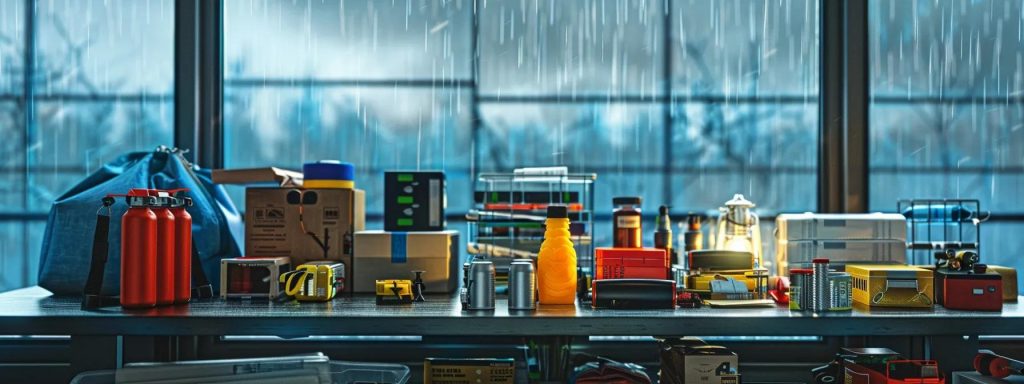
Storms can strike unexpectedly, making household preparedness essential. Homeowners must have a comprehensive plan including emergency kits, communication strategies, home protection, evacuation plans, pet safety, and preparations for various storm types. This article provides actionable guidance on assembling a first aid kit, managing power outages, and preparing for floods while integrating strategies such as using reliable tree service debary for necessary home maintenance.
What Are the Must-Have Items in a Storm Emergency Kit?
A storm emergency kit should include food, water, medical supplies, tools, and personal documents to help households survive prolonged outages. Essential items include non-perishable food, bottled water for at least three days, and a manual can opener. Other vital components consist of portable radios, flashlights, batteries, multipurpose tools, and a well-stocked first aid kit with medication, bandages, and antiseptics. These supplies are critical for emergency management during power outages and flood situations.
Which Food and Water Supplies Should You Include?
Include drinking and cooking water, along with canned fruits, vegetables, proteins, and snacks. Store at least one gallon of water per person per day and choose foods requiring minimal preparation. Add special dietary items, extra baby formula, or pet food for families with special needs.
What First Aid and Medical Supplies Are Necessary?
Your first aid kit should contain bandages, antiseptics, pain relievers, and any necessary prescription medications, plus an EpiPen if needed. Over-the-counter cold, allergy medications, and electrolyte powders are useful to prevent dehydration. Keeping this kit updated supports readiness during power outages and floods.
Which Tools and Emergency Devices Are Recommended?
Include a battery-powered or hand-crank flashlight, radio, multi-tool, and duct tape. A portable charger, spare batteries, and whistle are indispensable for signaling help, while a fire extinguisher and crowbar help secure damaged property during emergencies.
How to Prepare Personal Hygiene and Important Documents?
Pack soap, toothpaste, and moist towelettes along with important documents like insurance policies, IDs, medical records, and bank information in a waterproof container. This ensures vital records are accessible if evacuation becomes necessary and eases the recovery process afterward.
How Do You Create an Effective Family Communication Plan for Storms?

A robust family communication plan ensures that everyone stays in touch when emergency situations occur, even during power outages or network disruptions. The plan should identify multiple contact methods, designate an emergency meeting point, and include alternative communication tools.
What Information Should Be Included in an Emergency Contact List?
Maintain an updated list of emergency contacts such as local police, fire departments, hospitals, nearby family, workplace contacts, and neighbors. Offer both digital and physical copies for quick reference during an emergency.
How Can Families Stay Informed During a Storm?
Ensure family members have battery-operated radios or access to mobile apps for weather updates and emergency alerts. Using trusted sources like FEMA and NOAA helps families receive accurate, timely information.
What Are the Best Practices for Communicating During Power Outages?
Designate a central contact and an alternate meeting place. Use text messages and emergency apps when voice calls may fail. Regular drills and plan reviews reinforce the communication protocol among all members.
What Are the Key Steps to Protect Your Home From Storm Damage?
Minimize storm damage by taking proactive steps to secure your property. This includes assessing weak points, anchoring objects that could become projectiles, and reducing repair costs by reinforcing vulnerable areas.
How Do You Secure Windows, Doors, and Outdoor Items?
Board up vulnerable windows and reinforce doors before the storm. Move or secure outdoor furniture, grills, and loose items to prevent them from becoming dangerous projectiles.
What Home Insurance Considerations Should You Review?
Review your home insurance policy to ensure adequate storm coverage. Check deductibles, coverage limits, and terms for flood or wind damage, and consult your provider for any necessary updates.
How Can You Prepare Your Property for Different Storm Types?
Improve your home based on the storm type. Install storm shutters in hurricane-prone areas, or reinforce drainage systems for flood-prone zones. Routine maintenance, such as roof inspections and timely tree trimming (via reliable tree service debary if needed), further reduces risk.
How Should You Develop a Safe and Practical Evacuation Plan?

A safe evacuation plan outlines when and how to leave during an emergency. It should include clear instructions, designated meeting points, and a checklist of essential items to take along, ensuring that evacuations are timely and orderly.
When Should You Evacuate: Understanding Storm Watches and Warnings?
Evacuate when local authorities issue evacuation orders or when storm warnings indicate imminent danger. Understanding the difference between a watch (indicating potential danger) and a warning (indicating severe conditions) is critical.
How Do You Identify and Plan Evacuation Routes?
Identify several evacuation routes that avoid flood-prone areas and include safe community shelters. Multiple routes provide alternatives if one becomes impassable.
What Essentials Should You Take When Evacuating?
Pack crucial items such as personal identification, mobile devices, the first aid kit, medications, and cash. A complete storm kit with food, water, and important documents is also essential to support immediate survival needs upon arrival at a safe location.
How Can You Prepare Pets for Storm Emergencies?
Pets require special preparation during storms. A pet-specific kit helps ensure your animal companions remain safe and comfortable amid chaotic conditions.
What Should Be Included in a Pet Emergency Kit?
Stock the pet kit with food, fresh water, medications, leashes, and waste disposal bags. Including a familiar toy or blanket can provide comfort during stressful situations.
How Do You Safely Evacuate With Pets?
Before evacuating, ensure your pets are microchipped and have updated identification. Use secure carriers or leashes and plan for pet-friendly evacuation routes and shelters.
What Are the Best Practices for Pet Safety During Storms?
Keep pets indoors and provide a quiet, secure space away from windows. Regularly update their emergency information and practice drills that include your pets to reduce their stress.
What Are the Specific Preparations for Different Types of Storms?

Each storm type requires tailored preparations. Whether facing hurricanes, tornadoes, floods, or winter storms, specific actions and supplies can protect your home and family.
How to Prepare for Hurricanes: Safety Tips and Seasonal Advice?
For hurricanes, install storm shutters, secure loose debris, and plan evacuation early. Keep an emergency kit with ample water and supplies, and monitor local weather forecasts.
What Are the Best Practices for Tornado Safety and Shelter?
When tornadoes threaten, take shelter in a basement or interior room on the lowest floor, away from windows. Prepare a safe area stocked with a first aid kit, emergency blankets, and essential supplies, and practice regular drills.
How to Get Ready for Floods and Winter Storms?
For floods, elevate important items, seal basement windows, and plan routes to higher ground. In winter storms, stock extra blankets, non-perishable food, and heating supplies while reviewing home insurance and emergency management strategies.
Where Can You Find Trusted Resources and Tools for Storm Preparedness?
Reputable sources like FEMA and NOAA provide up-to-date guidelines, checklists, and real-time updates essential for storm preparedness. Interactive checklists and emergency kit templates further streamline planning.
How Do FEMA and NOAA Support Household Preparedness?
FEMA and NOAA offer alerts, educational materials, evacuation maps, and practical advice for securing homes, proving invaluable in risk mitigation and recovery efforts.
What Are the Best Emergency Kits and Products Available?
Numerous products such as pre-assembled storm kits, first aid kits, and portable radios are available. Refer to product reviews and select options that best meet your household’s needs:
| Product | Feature | Advantage | Price Range |
|---|---|---|---|
| Comprehensive Emergency Kit | Includes food, water, medications | All-in-one solution for basic survival | $50–$100 |
| First Aid Kit | Medical supplies and medications | Critical for immediate treatment | $20–$50 |
| Portable Radio with Charger | Battery powered, hand crank | Continuous updates when power is out | $30–$70 |
How Can Interactive Checklists and Templates Help You Stay Prepared?
Digital templates and checklists assist in staying organized with purchasing, inventory, and emergency contact updates, supporting proactive planning and overall readiness.
Frequently Asked Questions
Q: What basic items should be in every storm emergency kit? A: Include water, non-perishable food, first aid supplies, essential medications, flashlights, batteries, and waterproof-stored documents.
Q: How do I determine when to evacuate during a storm? A: Follow official storm watches, warnings, and instructions from local authorities. Understand the difference between a watch and a warning in advance.
Q: What communication methods work best during power outages? A: Use battery-operated radios, mobile phones with extra power banks, and emergency alert apps to stay informed.
Q: Can pet emergency kits be combined with my family’s storm kit? A: It is best to prepare a separate pet kit to ensure streamlined care for your animals.
Q: Where can I find reliable storm preparedness information? A: Trusted resources include FEMA, NOAA, and local emergency management agencies for up-to-date guidance and checklists.
Ensuring Ongoing Storm Preparedness for Your Home and Family
Comprehensive storm preparedness safeguards both home and family against unforeseen emergencies. By assembling a complete emergency kit, establishing a robust communication plan, fortifying your home, and formulating an effective evacuation strategy, you can minimize damage and protect lives. Regularly reviewing and updating these plans—along with services like reliable tree service debary for essential maintenance—ensures optimal readiness when storms strike.